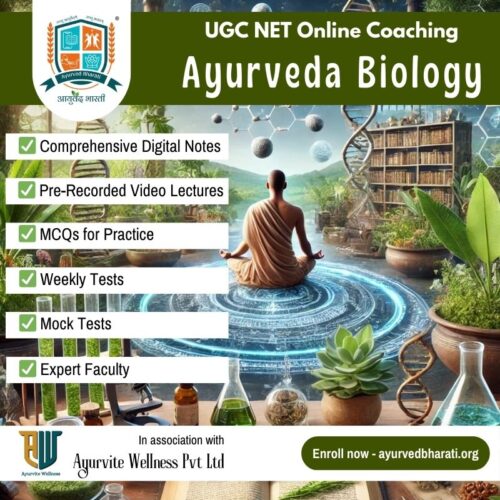UGC NET Ayurveda Biology coaching
- Course Validity: 12 months
- Resources: LMS and Digital Library Access – Pre-recorded video lectures in Hindi, Downloadable Digital Notes in English, MCQs & Mock Tests
- Content: Covers entire UGC NET Ayurveda Biology syllabus
- Language: Lectures – majorly in Hindi, Reading materials & test series in English
UGC NET Ayurveda Biology Coaching – Key Highlights
- Mode: 100% Online
- Study Materials: Comprehensive downloadable digital notes, pre-recorded videos, MCQs for practice, mock tests, printed book set of 3 books (can be purchased, not included in this course fee).
- Syllabus: Covers all 10 units recommended by UGC NET
- Expert Faculty: Experienced professionals specializing in Ayurveda and biology.
- Flexible Learning: Self-paced study with recorded lectures and accessible resources.
- Designed for Beginners & Experts: Tailored content for all levels of aspirants.
Click here for demo lessons/ videos
Limited Seats, have you booked your’s?
Q3. The Protection of Plant Varieties and Farmer’s Rights Act of India was enacted in:
Option A. 1952
Option B. 1971
Option C. 2001
Option D. 2022
Correct Ans – Option C (2001)
Explanation – The Protection of Plant Varieties and Farmers’ Rights (PPVFR) Act was enacted in 2001 to recognize and protect the rights of plant breeders and farmers in India. It is a key law supporting agricultural biodiversity and innovation.
Q4. Match the List-I with List-II.
| List-I (Food conversion factors) | List-II (Functions) |
| A. Ushma | I. Shaithilya |
| B. Vayu | II. Mruduta |
| C. Kleda | III. Apakarshana |
| D. Sneha | IV. Pachana |
Options:
- A-II, B-I, C-IV, D-III
- A-I, B-IV, C-III, D-II
- A-III, B-II, C-IV, D-I
- A-IV, B-III, C-I, D-II
Correct Ans – Option 4 (A-IV, B-III, C-I, D-II)
Explanation –
- Ushma helps in digestion (Pachana – IV)
- Vayu helps in elimination (Apakarshana – III)
- Kleda contributes to looseness or liquidity (Shaithilya – I)
- Sneha imparts softness or unctuousness (Mruduta – II)
Q5. While preparing a formulation, if the useful part of a drug is not mentioned, then what should be taken?
Option A. Leaves
Option B. Flowers
Option C. Root
Option D. Stembark
Correct Ans – Option A (Leaves)
Explanation – In classical Ayurvedic texts, when the specific part of a plant is not mentioned, leaves are typically used by default due to their common usage and accessibility.
Q6. What is the correct order of the following herbal formulations in increasing order of their potency?
A. Kalka
B. Hima
C. Swarasa
D. Phanta
E. Kwatha
Options:
- A, B, C, D, E
- E, D, C, B, A
- C, A, E, B, D
- D, B, E, A, C
Correct Ans – Option 3 (C, A, E, B, D)
Explanation –
- Swarasa (fresh juice) is most potent
- Followed by Kalka (paste)
- Then Kwatha (decoction),
- Hima (cold infusion),
- And least potent is Phanta (hot infusion)
Q7. Regulation of glycolytic pathway in muscles occurs via:
A. Allosteric modulation
B. Enzyme turnover
C. Feedback regulation
D. Compartmentalization
E. Covalent modification
Options:
- A, B, E Only
- A, C, E Only
- A, C, D, E Only
- C, D, E Only
Correct Ans – Option 3 (A, C, D, E Only)
Explanation –
Glycolysis regulation involves:
- Allosteric modulation of enzymes like PFK
- Feedback regulation through ATP, citrate, etc.
- Compartmentalization of metabolic enzymes
- Covalent modification such as phosphorylation
Enzyme turnover is a longer-term mechanism and not direct regulation of the pathway.
Q8. A color blind man marries a homozygous normal woman. What is the probability of the son being color blind?
Option A. 1/2
Option B. 1/4
Option C. 0
Option D. 1
Correct Ans – Option C (0)
Explanation –
Color blindness is an X-linked recessive disorder. A color blind man (XʹY) and a homozygous normal woman (XX) will have sons with the Y chromosome from father and a normal X from mother, making all sons normal. Daughters will be carriers.
Q9. The colloidal “ruby” gold nanoparticles properties were discovered by:
Option A. Erwin Muller
Option B. Michael Faraday
Option C. William Shaockley
Option D. Robert Hook
Correct Ans – Option B (Michael Faraday)
Explanation –
Michael Faraday discovered the optical properties of colloidal gold in the 1850s, which is why gold nanoparticles show a red “ruby-like” color due to surface plasmon resonance.
Q10. To create a genetic map of a gene on an autosome, which of the following crosses need to be done?
Option A. Back cross
Option B. Test cross
Option C. Reciprocal cross
Option D. Double reciprocal cross
Correct Ans – Option A (Back cross)
Explanation –
Back cross is commonly used in genetics to determine linkage and map genes by crossing F1 with one of the parent genotypes, allowing easier identification of recombination events.

